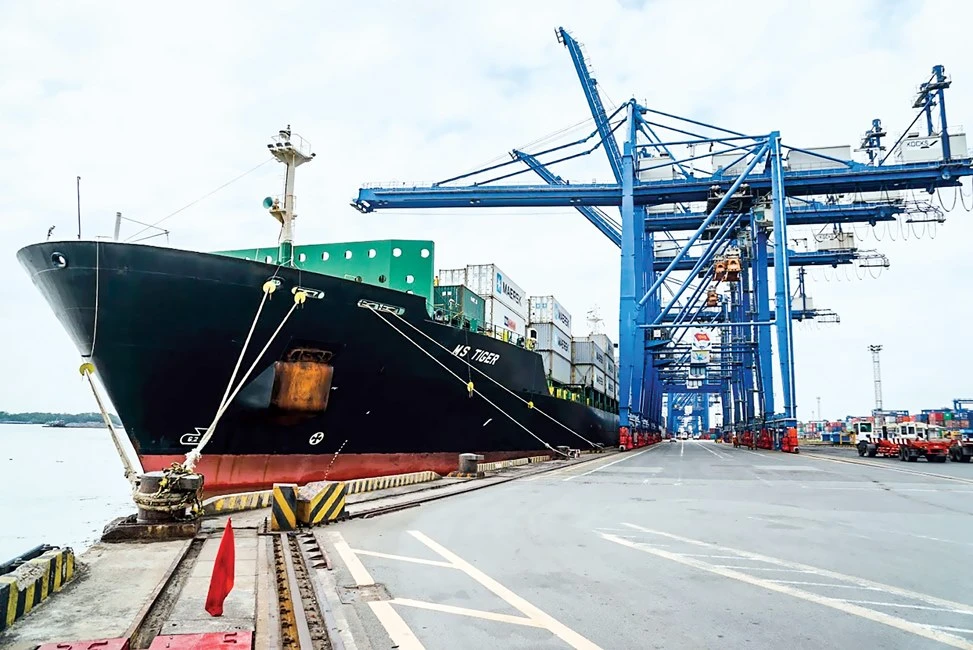
Logistics is responsible for moving products and services to consumers at lowest cost. To meet this need, it is necessary to sync the current fragmented national logistics system.
We have opened a logistics sector for foreign companies and investors since 2013, but the infrastructure for applying logistics activities is still limited, reducing the competitive ability of Vietnamese enterprises in both domestic and international markets.
Lack of logistics centers
logistics centers play an important role in total logistics functioning as a place for storing, loading, unloading, classifying, grouping, creating added value, and transporting of goods.
logistics centers are central for promoting domestic and international trade, linking different economic units together, and encouraging consumption of products and services.
They are very important in optimizing the flow of products, services, money and information, besides support in import and export activities, improving and increasing competition in enterprises. logistics centers also link and integrate different economic sectors together.
Similar to classifying the warehouse and storage yard in trade and commerce, logistics centers can be classified on criteria based on operating size and scope, such as national level, area level, province level, or regional and international level. The gathering of many different logistics centers forms a logistics hub.
logistics services were first mentioned in the Commerce Law in 2005. However, it was only as late as 3 July 2015 that decision 2012/QD-TTG on planning and developing a nationwide network of logistics centers by 2020 was issued. But so far, we still do not have a master plan or a strategy to develop this sector completely.
The slowness of this process is explained by the newness of this topic. Even in policies, economic strategies and plans to develop economy and society over 2016-2020, the logistics centers are not mentioned. This shows that the transformation, from economy based on cheap labor and natural resources to economy based on technology, high productivity and effectiveness is still far away.
Fragmented logistics system
Over the last ten years, to meet the demand of high growth of distributing, delivering product and services, especially via containers goods, many distribution centers and domestic ports were established. We have 8 ICD ports in the North, including Gia Lam, My Dinh in Ha Noi, Thuy Van in Phu Tho, Hai Duong in Hai Duong, Ninh Phuc in Ninh Binh, Hoa Xa in Nam Dinh, Tien Son in Bac Ninh and Lao Cai in Lao Cai.
The cargo volumes in the South have been much more than in the North, 70% of containers in Vietnam are unloaded here. Hence, the ICD in the South are encouraged to establish and develop custom and storage services for clients. There are currently 9 ICD ports in the South, including Phuoc Long Transimex, Binh Hoa, Ben Nghe, Song Than, Tamamexco, Phuc Long, Sotrans, Tan Cang. Furthermore, some ports have been installing several service points at border gates to support clients with customs and product checking process.
First, the transportation system which has been invested in gradually, is still fragmented and not linked to each other. It lacks logistics centers to support logistics operations. The size of current logistics centers is small, less than 10 ha, while the popular size for it in other countries is 1,500 ha.
Furthermore, the current logistics centers are owned by private enterprises to meet their clients’ demand. We lack national level logistics centers which are same level with that of other countries. This causes the logistics services to cost more in Vietnam than in other regional countries, creating bottle necks in transferring products between different areas, thereby reducing product quality and decreasing the competitive ability of enterprises.
Currently, many apartment buildings and residential areas are being developed in many provinces and cities. Especially, since the time government allowed developers to exchange infrastructure projects for land banks, these projects have been rising significantly. However, these projects are constructed without care of any logistics system development, such as transportation facilities, drainage system, schools, and entertainment areas. Hence, issues of traffic jams, water flooding and air pollution remain unresolved.
Making a master plan for a logistics industry, especially by constructing logistics centers based on national criteria is necessary and urgent.
For a land logistics system, firstly we should construct and operate logistics centers along 1A highway, Ho Chi Minh highway and the highways that link to border gates of China, Laos and Cambodia. These will be the backbone to construct other industrial zones and logistics hubs, link different areas and economic zones, promote distribution of products, support export and import activities, and help provinces to sell their products.
So far, Vietnam still does not have any functional logistics center. The current centers are just an extension of ICD ports with some added functions. They cannot be termed as logistics hubs or logistics centers.
If we maintain the old thinking, allow developers to use coastlines for constructing resorts, seaport system development will be fragmented and the coastal areas will be destroyed by BOT or smaller projects. These will only destroy the tremendous potential that the logistics sector can bring for the country.




















